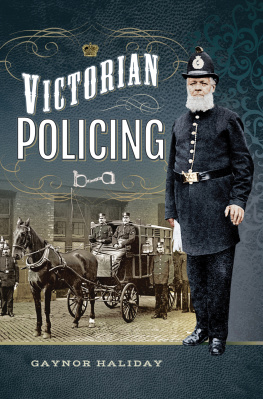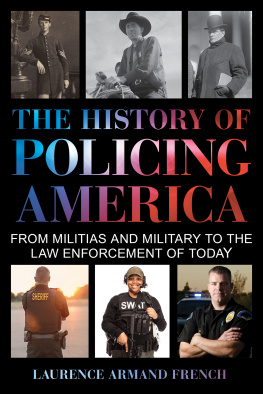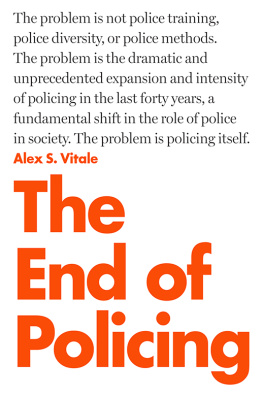TO SERVE
AND PROTECT
T HE HISTORY OF POLICING

Published in 2017 by Britannica Educational Publishing (a trademark of Encyclopdia Britannica, Inc.) in association with The Rosen Publishing Group, Inc.
29 East 21st Street, New York, NY 10010
Copyright 2017 by Encyclopdia Britannica, Inc. Britannica, Encyclopdia Britannica, and the Thistle logo are registered trademarks of Encyclopdia Britannica, Inc. All rights reserved.
Rosen Publishing materials copyright 2017 The Rosen Publishing Group, Inc. All rights reserved.
Distributed exclusively by Rosen Publishing.
To see additional Britannica Educational Publishing titles, go to rosenpublishing.com.
First Edition
Britannica Educational Publishing
J.E. Luebering: Director, Core Reference Group
Anthony L. Green: Editor, Comptons by Britannica
Rosen Publishing
Lionel Pender: Editor
Nelson S: Art Director
Brian Garvey: Designer
Cindy Reiman: Photography Manager
Karen Huang: Photo Researcher
Introduction and conclusion by Michael Ray.
Library of Congress Cataloging-in-Publication Data
Names: Pender, Lionel, editor.
Title: To serve and protect : the history of policing / edited by Lionel Pender.
Description: First edition. | New York, NY : Britannica Educational Publishing in association with The Rosen Publishing Group, Inc., 2017. | Series: Law Enforcement and Intelligence Gathering | Includes bibliographical references and index.
Identifiers: LCCN 2016020482 | ISBN 9781508103578 (eBook)
Subjects: LCSH: Police--History--Juvenile literature.
Classification: LCC HV7903 .T62 2017 | DDC 363.209--dc23
LC record available at https://lccn.loc.gov/2016020482
Photo credits : , interior pages (background) stefano carniccio/Shutterstock.com
CONTENTS
T he relationship between police and the people that they serve and protect has changed rather dramatically over the centuries. Perhaps more surprising, however, are the ways in which things have remained the same. The earliest societies used mediation to maintain peace and stability among their citizens. In the twenty-first century, at a time of increased scrutiny regarding the conduct of armed law-enforcement officers, such techniques were the focus of renewed interest. Peer intervention groups sought to interrupt the cycles that often fueled violent crime in urban areas, and these methods demonstrated some measure of success. Still, this model did not achieve widespread acceptance, and it still fell to police to enforce laws and to pursue those who broke them.
The professionalization of policing duties was a process that took centuries, and the creation of independent, civilian bodies of peace officers employed by the state is a relatively recent historical development. Enforcement of laws and community norms was done at the local, or even personal, level, and criminal investigations were left to those individualsoften the victims of the crimes themselveswho had the time and money to pursue them. Indeed, money would be a dominant factor in policing until the modern era, and the various systems of bounties, stipends, rewards, and patronage led to widespread abuse. Perhaps the most outrageous example of this was Jonathan Wild, an eighteenth-century British thief who organized a criminal network that stole items and resold them to their original owners.

Police officers patrol Los Angeles International Airport in California on March 22, 2016.
Throughout much of history, military forces were often used as a primary or supplementary law-enforcement body. France created one of the earliest modern police forces in the sixteenth century when it enlisted former soldiers and officers to curtail the criminal activities of other disbanded soldiers in the French countryside. The centralized command and control structures that typify military organizations have both advantages and disadvantages when applied to law enforcement, however, and a body designed to ward against foreign threats is not necessarily suited to promote domestic harmony. One of the earliest British professional police forces was actually in Dublin, Ireland, and it functioned as much as an extension of Londons will as a peacemaking body. In the United States, lawmakers explicitly forbade the use of the US military as a domestic law-enforcement body with the Posse Comitatus Act of 1878.
It was perhaps ironic, then, that the United States in the twenty-first century saw an increasing militarization of its local police forces, as surplus battlefield equipment from the wars in Iraq and Afghanistan trickled down to municipalities and aggressive policing techniques (including the use of deadly force) were employed for even minor offenses. These steps were taken in spite of a dramatic decline in the overall crime rate. The suicide hijackings of September 11, 2001, and subsequent attacks in London, Madrid, Paris, and Brussels saw an increased focus on international terrorism as a domestic law-enforcement issue, and local and national police forces struggled to achieve a balance between security and respect for the privacyand indeed, the very livesof law-abiding citizens.

P olicing can be broadly defined as practices meant to enforce common standards and to maintain order in a community. In this sense, policing is much older than the creation of any armed force specifically formed for such a task. The activity of policing existed for thousands of years before the introduction of police as a distinct body.
The earliest civilizations found ways of enforcing laws and maintaining order. Sometimes law enforcement was in the hands of religious authorities or the military instead of political rulers. Some early police forces developed from the personal bodyguards of rulers or warlords. Occasionally, in the absence of a better means of preventing crime, groups of citizens in a community banded together for mutual protection. Often police in ancient civilizations performed various tasks, including garbage disposal and firefighting, that were not related to stopping crime.
The first police forces were created in Egypt in about 3000 BCE . Egypt then was divided into forty-two regions called nomes. Each of these regions had an appointed official who was responsible for justice and security. He was assisted by a chief of police, whose formal title was sab heri seker , meaning chief of the hitters. (The hitters were a body of men who collected taxes, among other duties.)
In the city-states of ancient Greece, policing duties were assigned to magistrates. Different classes of magistrates had different responsibilities, some for city cleanliness, others for keeping order in the marketplace or enforcing standards of measure. A group known as the Eleven dealt with courts, prisons, and criminal justice. To carry out their duties, the magistrates depended in part on the military and also on a corps of 300 Scythian slaves purchased after the Greco-Persian Wars. Lightly armed, the Scythian slaves maintained peace and order in various public places.














